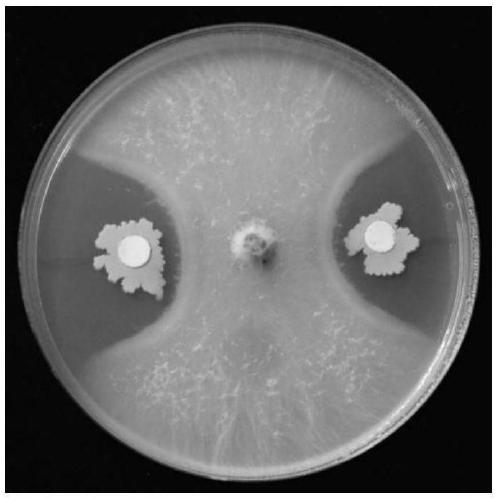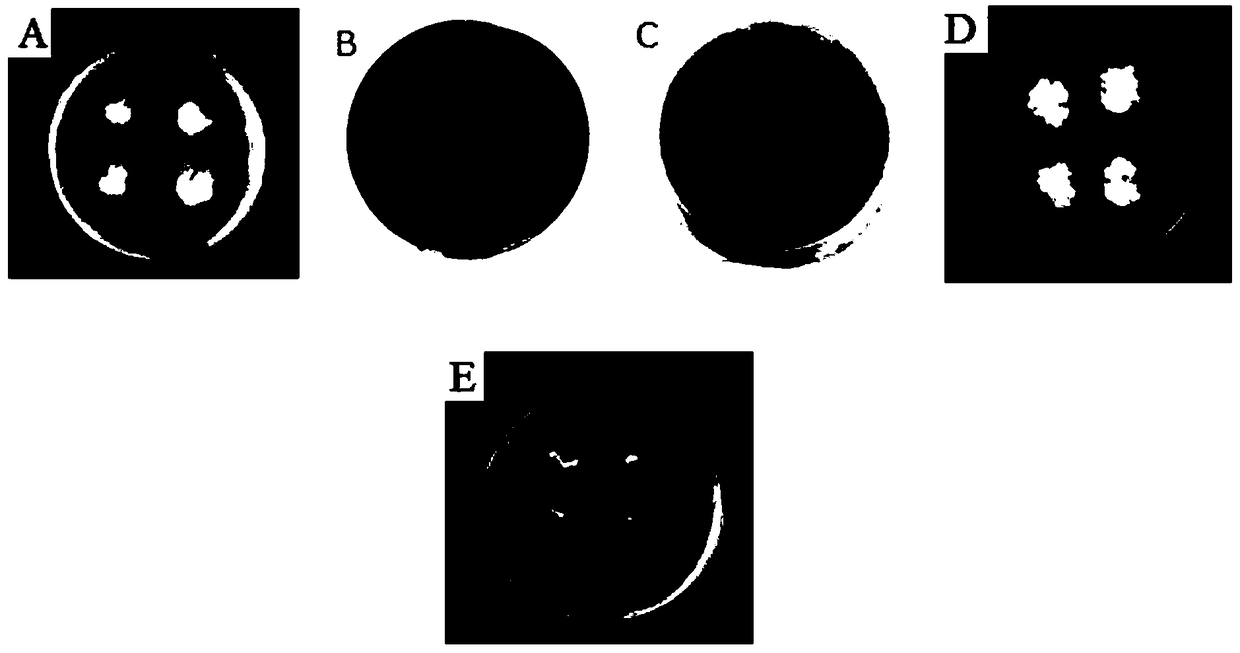Polygonatum cyrtonema endophyte strain ZJU-C612-1 and application thereof
A technology of Polygonatum polyflora and endophytic bacteria, applied in the field of microorganisms
- Summary
- Abstract
- Description
- Claims
- Application Information
AI Technical Summary
Problems solved by technology
Method used
Image
Examples
Embodiment 1
[0024] Embodiment 1, the screening of bacterial strain ZJU-C612-1
[0025] Polygonatum multiflora was collected in Jiangshan City, Zhejiang Province (28"22'26.97 north latitude, 118"30'36.14 east longitude), provided by the Technology Promotion Station of Baoan Township, Jiangshan City, Zhejiang Province. CN103122331A "A Method for Separating Endophytic Bacteria from Plants"), a total of 11 strains of endophytic bacteria were isolated and obtained.
[0026] The screening of antagonistic strains adopts the plate confrontation method, and the specific steps are:
[0027] (1) Activate the endophytic bacteria on the LB solid plate, select a ring of single colony and inoculate it into 1 mL of LB liquid medium, and place it in a shaking incubator at 37°C and 200r / min for 12 hours as a strain, with 1% (Volume %) Inoculum amount Inoculate the endophytic bacteria into a new LB liquid medium (4mL / 10mLEP tube), culture at 37°C with shaking at 200r / min for 24h, and obtain endophytic bact...
Embodiment 2
[0032] Embodiment 2, identification of bacterial strain ZJU-C612-1
[0033] The 16S rDNA gene sequence of strain ZJU-C612-1 was amplified and sequenced with universal primers 27F and 1492R, and a sequence with a size of 1425bp was obtained. The sequence was uploaded to GenBank to obtain the gene accession number: MH 298776. Blast comparison analysis was performed on the sequence on the NCBI website, and the results showed that its similarity with Bacillus velezensis strain GQJK49 (CP021495.1) was 99%.
[0034]Strain ZJU-C612-1 was cultured on LB medium at 28°C for 24 hours, and the single colony was similar to a circle, with irregular edges, wrinkled protrusions, rough surface, opaque, dry, and the colony was light yellow ( figure 2 A). The results of scanning electron microscopy showed that the bacteria were rod-shaped, with a size of (0.5-0.7) μm×(1-3) μm ( figure 2 B), the spores are oval, middle or terminal, and the length is (0.6~1) μm ( figure 2 C). The bacterial ...
Embodiment 3
[0038] Embodiment 3, bacterial strain ZJU-C612-1 produce the mensuration of bacteriostatic substance
[0039] 1. Determination of Protease Production Ability
[0040] Spot the strain ZJU-C612-1 on the protease detection plate (A: Dissolve 8g of skimmed milk powder in 300mL of distilled water, sterilize at 115°C for 10min, B: add 8g of agar with distilled water to 300mL, sterilize at 121°C for 20min, A and B respectively sterilized and then mixed), cultured in the dark at 30°C for 2 days, and it was found that the edge of the strain ZJU-C612-1 produced an obvious transparent circle ( image 3 A), indicating that strain ZJU-C612-1 can produce protease.
[0041] 2. Determination of the ability to produce chitinase
[0042] Bacterial strain ZJU-C612-1 was spot-inoculated on the culture medium (ammonium dihydrogen phosphate 1.0g, potassium chloride 0.2g, magnesium sulfate hydrate 0.2g, w=1% colloidal chitin) as the only carbon source. Butin 100mL, agar 20g, distilled water 1000m...
PUM
 Login to View More
Login to View More Abstract
Description
Claims
Application Information
 Login to View More
Login to View More - R&D
- Intellectual Property
- Life Sciences
- Materials
- Tech Scout
- Unparalleled Data Quality
- Higher Quality Content
- 60% Fewer Hallucinations
Browse by: Latest US Patents, China's latest patents, Technical Efficacy Thesaurus, Application Domain, Technology Topic, Popular Technical Reports.
© 2025 PatSnap. All rights reserved.Legal|Privacy policy|Modern Slavery Act Transparency Statement|Sitemap|About US| Contact US: help@patsnap.com



